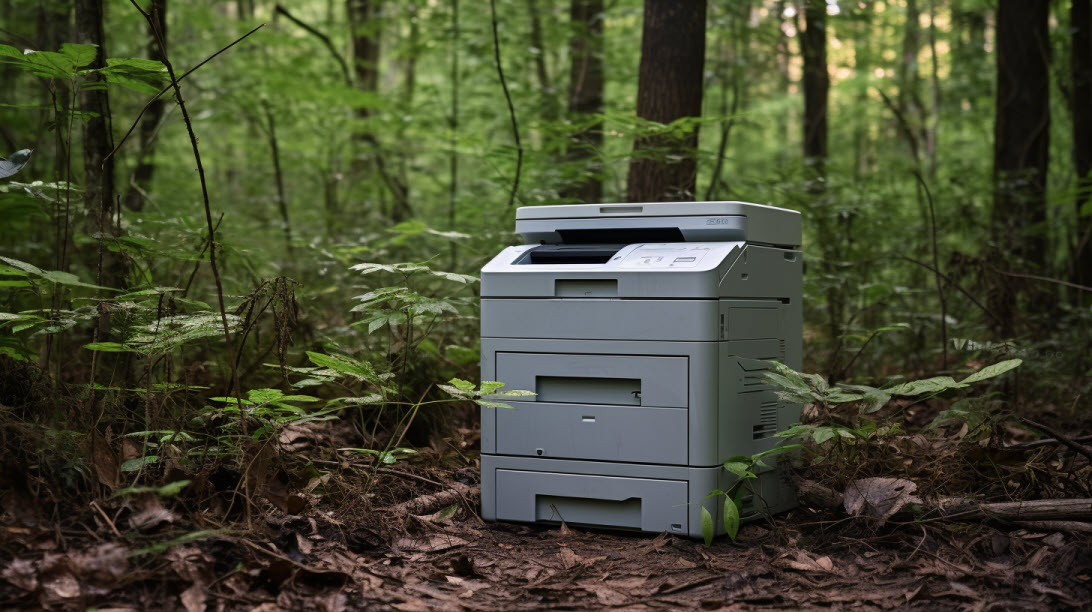– Saving Costs and the Environment
In a rapidly changing world, energy efficiency has become a crucial consideration for businesses striving to reduce costs, minimize environmental impact, and enhance sustainability.
In this article, we will explore the importance of energy efficiency in the workplace, outline the benefits of making offices more energy efficient, tips for optimizing office equipment energy consumption, and provide practical guidance for selecting energy-efficient computers, monitors, printers, and copiers.

Benefits of Making Your Office More Energy Efficient
Implementing energy-efficient practices in the workplace offers a range of advantages, including cost savings, reduced carbon footprint and carbon emissions, and enhanced Environmental, Social, and Governance (ESG) performance.
Cost Savings: According to the Sustainable Energy Authority of Ireland (SEAI), implementing energy-saving initiatives can reduce energy bills by up to 20%. By optimizing energy usage through efficient equipment, lighting, and HVAC systems, businesses can lower their operational expenses and allocate resources more effectively.
Reduced Carbon Footprint: Energy efficiency plays a crucial role in reducing greenhouse gas emissions and combatting climate change. The European Environment Agency (EEA) highlights that energy efficiency measures contribute to the EU’s goal of reducing greenhouse gas emissions by at least 40% by 2030. By consuming less energy, businesses can significantly decrease their carbon footprint and contribute to a more sustainable future. (Source: EEA – Climate Change Mitigation)
Enhanced ESG Performance: Embracing energy efficiency aligns with the principles of Environmental, Social, and Governance (ESG) investing. By reducing environmental impact, businesses enhance their ESG performance, which has become increasingly important for investors and stakeholders. Adopting energy-efficient practices demonstrates a commitment to sustainable business operations, positioning the company as a responsible and attractive investment opportunity. (Source: ESG Investing Guide)
Regulatory Compliance and Incentives: European and Irish governments provide regulatory frameworks and incentives to encourage energy efficiency. For example, the Irish Sustainable Energy Authority (SEAI) offers grants, funding, and support programs to businesses implementing energy-efficient measures. Compliance with energy efficiency regulations ensures alignment with national and European sustainability goals. (Source: SEAI – Business Grants and Supports)
These benefits of energy efficiency are supported by reputable European and Irish sources such as the Sustainable Energy Authority of Ireland (SEAI), the European Environment Agency (EEA), and industry reports on ESG investing.
By leveraging these resources and implementing energy-efficient practices, businesses can enjoy cost savings, reduce their environmental impact, and enhance their ESG performance.
Now let’s look at best practices when choosing energy-saving office equipment.

Choosing Energy-Efficient Computers
When selecting energy-efficient computers for your workplace, it’s important to consider key factors that contribute to their energy-saving capabilities.
Key factors to consider
Energy Consumption Ratings: Energy consumption ratings provide valuable insights into a computer’s efficiency. Look for information from sources like the International Energy Agency (IEA) or the European Energy Efficiency Directive, which establish standards and guidelines for energy efficiency in electronic devices.
Processor Efficiency: The efficiency of the computer’s processor impacts its overall energy usage. Advanced processors designed for energy efficiency, such as those based on Intel’s Low Power Technologies or AMD’s Energy-Efficient Processors, can help reduce energy consumption without compromising performance.
Power Management Capabilities: Computers with effective power management capabilities enable optimal energy utilization. Look for features like advanced power-saving modes, sleep mode, and power management software that allow customization and control of energy usage.
Using Sleep mode
Utilizing sleep mode and power management features in computers is a key strategy for reducing energy consumption in the workplace.
Benefits of sleep mode and power management features include:
Reduced Energy Consumption: Sleep mode and power management settings significantly reduce the amount of energy consumed by laptop and desktop computers during periods of inactivity. By automatically adjusting power usage, computers can save substantial energy without impacting productivity.
Quick Recovery and Enhanced User Experience: Sleep mode enables computers to resume function but without having to boot up from “cold”. This also provides a seamless user experience, allowing employees to get back to work without significant delays.
Customize Display and Hard Drive Power Settings: Fine-tune display and hard drive power settings to minimize energy consumption. Set the display to turn off after a specified period of inactivity and configure the hard drive to enter idle mode when not in use.
Ensure Wake-on-LAN Compatibility: If remote management or maintenance is required, ensure that computers are configured to support Wake-on-LAN functionality. This allows systems to be remotely powered on when necessary, minimizing the need for keeping computers active at all times.

Selecting Energy-Efficient Printers and Copiers
Choosing energy-efficient printers and copiers is crucial for optimizing energy consumption in the office.
Factors to consider when selecting energy-efficient printers and copiers include:
Energy-Saving Features: Look for devices with built-in energy-saving features, such as duplex printing, automatic sleep mode, quick warm-up times, and power management options. These features minimize energy consumption during operation and idle periods.
Energy Consumption Ratings: Consider devices with low energy consumption ratings first.
Eco-Labels and Certifications: Look for printers and copiers with eco-labels and certifications, such as Energy Star or Blue Angel. These labels indicate compliance with stringent energy efficiency standards and environmental requirements.
Tips for selecting energy-efficient printers and copiers:
Duplex Printing: Opt for devices with duplex printing capabilities to reduce paper usage and energy consumption by automatically printing on both sides of the paper.
Sleep Mode and Power Management: Choose devices with automatic sleep mode and power management features to minimize energy waste during periods of inactivity.
Quick Warm-Up Time: Consider devices with quick warm-up times to reduce energy consumption during the start-up phase.

Office Energy Efficiency Quick Wins
Improving energy efficiency in the office doesn’t always require complex solutions. Simple and cost-effective measures can make a significant impact.
By reducing standby power, utilizing power strips, and implementing equipment schedules, businesses can achieve quick wins in energy efficiency.
Well-maintained office equipment can also read to reduced electricity consumption.
Reducing Standby Power: Encourage employees to turn off computers, monitors, printers, and other equipment at the end of the day instead of leaving them in ‘Standby mode’. Standby power, also known as vampire power, can account for a significant portion of energy consumption. By using power strips with built-in switches or smart power outlets, standby power can be easily eliminated when equipment is not in use.
Utilizing Power Strips: Plug office equipment, such as computers and peripherals, into power strips. Power strips allow for convenient on/off switching of multiple devices at once. This prevents phantom loads and reduces energy waste by completely cutting off power supply to equipment when not in use.
Implementing Equipment Schedules: Set up equipment schedules or timers to automatically power down non-essential devices during evenings, weekends, and holidays. This ensures that equipment is not left unnecessarily powered on, saving energy and reducing operational costs.

Long-Term Office Energy Savings
Achieving long-term energy savings requires strategic planning and implementation.
By investing in energy-efficient lighting, conducting energy audits, and implementing energy management systems, businesses can make significant strides in energy efficiency and reduced electricity consumption.
Investing in Energy-Efficient Lighting: Upgrade to energy-efficient LED lighting systems, which consume significantly less energy than traditional artificial lights. LED lights have longer lifespans and provide better overall light quality.
Conducting Energy Audits: Engage with energy efficiency professionals or consult energy auditors to assess the current energy usage in the office. Energy audits provide valuable insights into energy consumption patterns, identify areas of inefficiency, and offer recommendations for improvement.
Implementing Energy Management Systems: Adopt energy management systems (EMS) that enable real-time monitoring, analysis, and control of energy usage. EMS platforms provide data insights, allow remote control of energy-consuming systems, and facilitate ongoing optimization based on performance trends and user preferences.
Energy Efficiency as Passive Marketing
Energy efficiency in the workplace can serve as a powerful branding opportunity.
Communicating sustainability efforts and energy-efficient practices can enhance an organization’s reputation and appeal to stakeholders.
Communicating Sustainability Efforts: Highlight energy-efficient practices and sustainability initiatives on your website, social media platforms, and in marketing materials. Use engaging visuals, success stories, and data-driven metrics to effectively communicate the environmental benefits and cost savings achieved through energy efficiency.
Enhancing Reputation: Position your organization as a responsible and environmentally conscious entity by showcasing your commitment to energy efficiency.
Attracting Stakeholders: Engage stakeholders by sharing the positive impact of energy efficiency initiatives. Highlight the financial benefits, reduced environmental footprint, and employee engagement resulting from energy-efficient practices.
By leveraging energy efficiency as a branding opportunity, businesses can differentiate themselves from competitors, attract environmentally conscious customers, and strengthen relationships with stakeholders.
Conclusion
Investing in energy-efficient office equipment is a win-win situation for businesses and the environment.
By prioritizing energy efficiency in equipment selection, and focusing on office equipment energy use, businesses can lower their energy consumption, reduce energy costs, and make significant contributions to a greener future.

